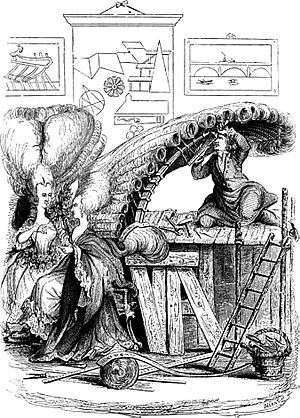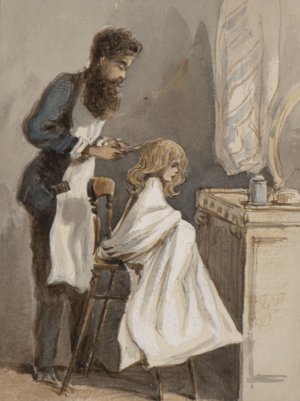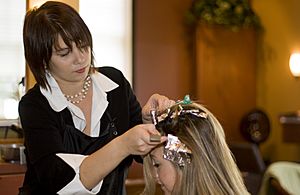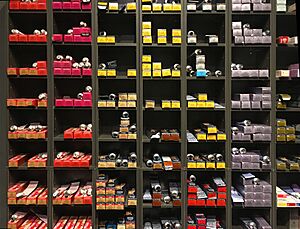Hairdresser facts for kids
A hairdresser is a professional who cuts, styles, and cares for hair. They help people change or keep their look. Hairdressers use different techniques like hair coloring, haircutting, and special treatments to make hair look great. You might also hear them called 'barbers' or 'hairstylists'.
Contents
History of Hairdressing
Hairdressing in Ancient Times
Hairdressing is a very old job, going back thousands of years. Ancient Greek writers like Aristophanes and Homer even mentioned it!
In ancient Greece and Rome, barbers (called koureus or tonsor) did more than just cut hair. They also styled hair, shaved beards, trimmed nails, and removed unwanted hair. Wealthy people often had their own hair stylists at home. Regular people visited barber shops. These shops were popular places to chat and hear the latest news.
In ancient Egypt, hairdressers used special tools and lotions. Wealthy men often had personal barbers. Since wigs were common, wigmakers also learned hairdressing skills. In many African cultures, hair was seen as a way to connect with spiritual beliefs. Hairdressers were very important in these communities. They spent hours washing, combing, oiling, and styling hair. They even had special ceremonies where tools were passed down to new stylists. After the year 1092, a rule from the Pope made all Roman Catholic priests shave their facial hair. This made hair care services even more popular.
Hairdressing in Europe
The word 'hairdresser' first appeared in Europe in the 1600s. It became a recognized job. Wealthy women wore big, fancy hairstyles, often decorated with jewels and ribbons. These elaborate styles took hours to create and maintain. Personal maids or other helpers usually did this work. Wealthy men also had people to care for their hair.
In France, men started styling women's hair. One of the first famous male hairdressers was Champagne. He opened a salon in Paris in the 1600s. Later, in the 17th century, hairstyles grew even taller! A hairdresser named Madame Martin made the 'tower' style popular. Women wanted their hair styled as tall as possible. Legros de Rumigny became the first official hairdresser of the French court. In 1765, he wrote a popular book called Art de la Coiffure des Dames. It showed his hair designs. De Rumigny even opened a school, the Academie de Coiffure, to teach others his skills. By 1777, Paris had about 1,200 hairdressers. Famous hairdressers like Léonard styled hair for important people, including Marie Antoinette. He created many fashionable styles, some towering five feet high!
Hairdressing in the 1800s
In the early 1800s, Parisian hairdressers still created many popular styles. Wealthy French women would have their favorite hairdressers style their hair from within their own homes. Hairdressing was mostly for rich people who could afford professional stylists or servants. In the United States, Marie Laveau was a famous hairdresser in New Orleans. She styled the hair of wealthy women in the 1820s. She was also known as the 'Voodoo Queen of New Orleans' and used her connections to help her religious practices. Later in the century, French hairdresser Marcel Grateau invented the 'Marcel wave.' This special wave needed a hot hair iron and a skilled hairdresser to create. During this period, hair salons started opening in towns and cities. Martha Matilda Harper created one of the first chains of hair salons, called the Harper Method.
Hairdressing in the 1900s
In the 20th century, Beauty salons became very popular, just like barbershops for men. These salons were places where women could get their hair done and also socialize. While some wealthy women still had stylists visit their homes, most women went to salons. Famous salons like Elizabeth Arden's Red Door Salon offered many services. This era saw big improvements in hairdressing tools. Electricity brought us permanent wave machines and hair dryers. These new tools made salon visits even more appealing. New ways to color hair were also invented, like those by Eugène Schueller in Paris. These allowed for many new and exciting styling techniques. After World War I, short haircuts like the bob cut became very trendy. Later, in the 1930s, more complex styles and the Marcel wave made a comeback. Hairdressing was also one of the few jobs that was widely accepted for women during this time, along with teaching and nursing.
Modern Hairdressing
Today, hairdressing is a diverse and creative field. Hairdressers use many skills to help people look their best.
Specialized Hair Services
Some hairstylists choose to specialize in certain areas. For example, a 'colorist' focuses mainly on coloring hair, using different shades and techniques. Other specialists might focus on cutting, styling for special events, or hair treatments.
Hairdressing as a Career
Becoming a Hairdresser in the United States
If you're interested in becoming a hairdresser in the United States, you usually need a special license to work. The rules for getting this license can be different in each state. Most states require you to have a high school diploma or GED and be at least 16 years old. You also need to graduate from a state-approved barber or cosmetology school. These full-time programs often take 9 months or more. After school, you'll take a state licensing exam. This usually includes a written test and a practical test of your styling skills. Hairdressers must pay for licenses, and sometimes they need to be renewed. About 44% of hairdressers are self-employed, meaning they own their own business or work independently.
See also
 In Spanish: Peluquero para niños
In Spanish: Peluquero para niños
- Asymmetric cut
- Hairstyle
- List of hairstyles
- Hollywood Makeup Artist and Hair Stylist Guild Awards
- Hot roots






